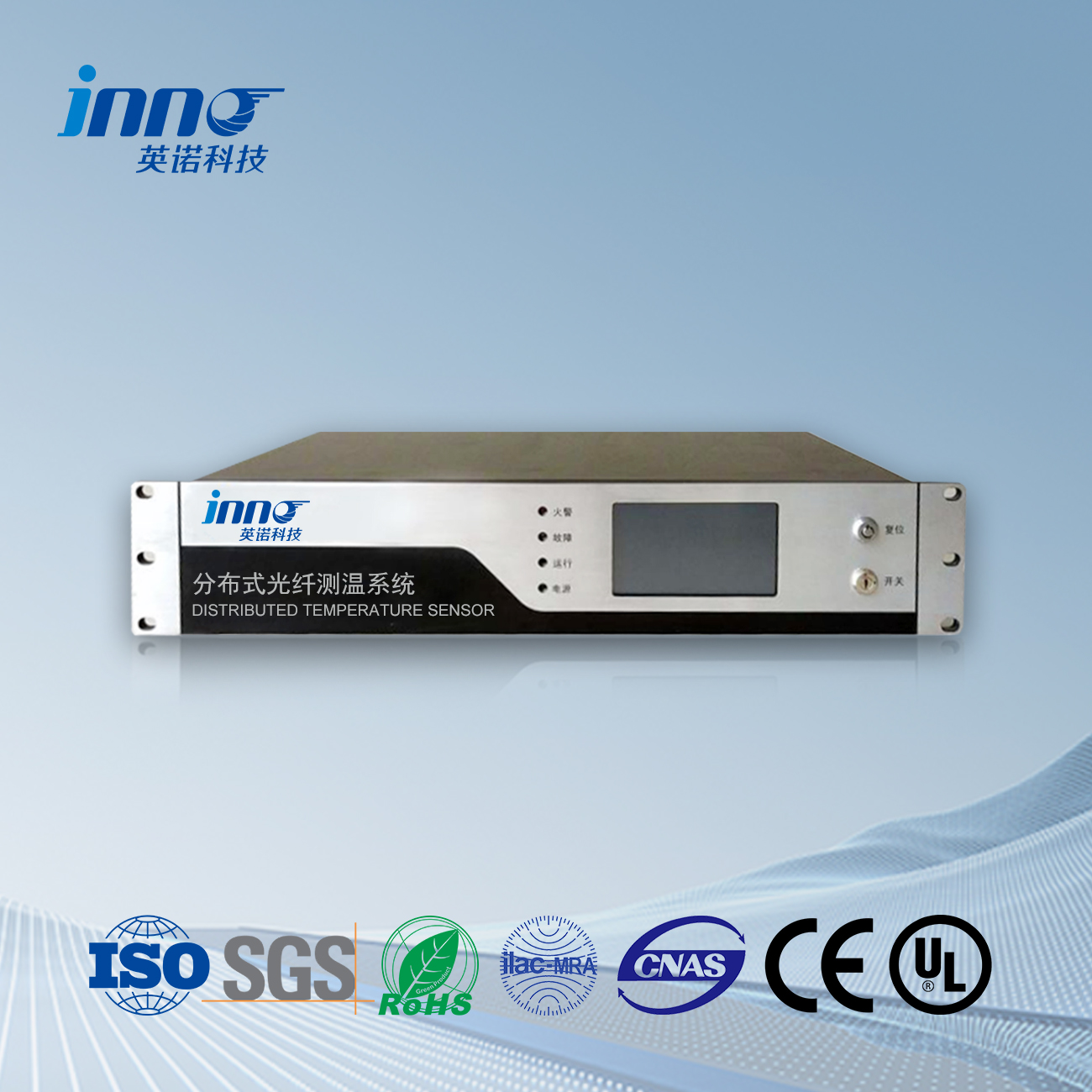Principle of Distributed Fiber Optic Temperature Measurement System
The distributed fiber optic temperature measurement system uses fiber optic as a temperature sensing element, which is not charged and inherently safe. Each point on the fiber optic is a temperature measuring element, eyiti o le ṣaṣeyọri wiwọn iwọn otutu nigbakanna ti awọn aaye pupọ lori iwọn nla kan. According to actual needs, the temperature sensing fiber optic can be arranged in a certain spatial position to achieve spatial measurement of the three-dimensional temperature field. Awọn distributed fiber optic temperature measurement technology is based on the Raman scattering characteristics of fiber optic and combined with the principle of fiber optic to achieve distributed temperature detection. By utilizing the temperature characteristics of the target system, it can achieve monitoring of thermal pipeline leakage, idabobo Layer ikuna, original oil pipeline leakage, partial discharge of cable joints, USB atẹ waya jijo, ati idido jijo ojuami.
Advantages of Pipin Okun Optic Iwọn Iwọn Iwọn Iwọn
The distributed fiber optic temperature measurement system is designed and manufactured specifically for the application of temperature measurement at a large range and multiple points. This system can measure the distribution of temperature field in the location of one or more (lilo okun opitiki yipada modulu) temperature measurement fibers. O ni awọn anfani ti ina resistance, bugbamu-ẹri, ipata resistance, high pressure resistance, itanna Ìtọjú resistance, iwọn wiwọn jakejado, ga ipo yiye, and convenient use.
The principle of distributed fiber optic temperature measurement
The distributed fiber optic temperature measurement system adopts a distributed fiber optic temperature sensing method, which utilizes the spontaneous Raman scattering signal generated by light transmission in the fiber optic and the principle of optical time-domain reflection (OTDR) to obtain spatial temperature distribution information. When a certain energy and width of laser pulse is injected into the fiber, it continuously generates Raman scattering light waves while transmitting in the fiber. The strength of these Raman scattering light waves is related to the absolute temperature of the fiber. After optical filtering, photoelectric conversion, amplification, and analog-to-digital conversion, the backward Raman scattering light is sent to the signal processing system for demodulation, and the temperature distribution on the entire fiber can be displayed in real time. Due to the very weak backward Raman scattering light wave, the thermometer requires very high gain, high bandwidth, ga ifamọ, and very low noise level to detect; Ni afikun, in order to achieve sufficient spatial positioning accuracy, the temperature measurement system must have sufficient acquisition speed, a certain bandwidth, and a narrow laser pulse. It is generally believed that the spatial positioning accuracy of the system depends on the acquisition speed of the system (a sampling speed of 100Mpa, a spatial positioning accuracy of ± 1 mita, and a positioning accuracy of 200Mpa, ± 0.5 mita). The spatial resolution of the system is the worst parameter when the system bandwidth, sampling speed, and laser pulse width are combined to form the spatial resolution, such as a 1G acquisition speed, a 100Mbps system bandwidth, and a 100ns laser pulse.
Composition of Distributed Fiber Optic Temperature Measurement System
1. Distributed fiber optic temperature measurement host
The independently developed distributed fiber optic temperature measurement host has high measurement accuracy, stable and reliable performance, and can fully meet the needs of various industries for temperature measurement.
2. Distributed fiber optic temperature measurement software
The supporting software of the system has comprehensive functions, including real-time data collection and display, constant/differential temperature alarm, historical data display, characteristic curve display, ati be be lo. The client software in the software system, namely the GUI interface (screen output), can visually display the temperature change information and position of the measured point on the monitoring screen.
3. Networking of distributed fiber optic temperature measurement system
The distributed fiber optic temperature measurement system (DTS) is convenient for networking and easy to install. It can directly lay the optical cable on the surface of the tested cable and focus on monitoring the cable joints.
Characteristics of distributed fiber optic temperature measurement products
Iwọn pinpin, with no temperature blind spots along the entire fiber optic laying route
Widely applicable to various environments, unaffected by any electromagnetic interference
Temperature alarm points and temperature change points can be set arbitrarily
Capable of recovery, long-term operation, and can be reused after temperature drops
Fast response speed, scanning in just a few seconds to tens of seconds
Simultaneously achieve high and low temperature alarms, early warning, and fire alarm signal output, ati be be lo
Can monitor and alarm based on temperature rise rate
Low system maintenance costs
High performance system security guarantee
On site fiber optic detectors are maintenance free
Distributed fiber optic temperature measurement application sites
Fire prevention and temperature alarm in coal mines and tunnels.
Temperature monitoring and alarm for oil depots, grain depots, hazardous material depots, cold storage, and other warehouses.
Temperature monitoring during the brewing process of distilleries, soy sauce and vinegar factories
Online temperature detection and overheating alarm for underground or overhead high-voltage cables.
Temperature distribution measurement and overheating alarm for large and medium-sized transformers.
Environmental temperature detection and fire alarm for substations.
Temperature distribution measurement, fault diagnosis, and overheating alarm of the generator set.
Temperature alarm systems for large cargo ships and oil tankers.
Temperature monitoring of the front and key parts of high-speed trains
Temperature detection and over temperature alarm of various pipeline networks in power plants.
Temperature detection and over temperature alarm for various large and medium-sized oil pipelines.
Dynamic temperature detection in the production process of chemical raw materials, photographic materials, food, ati be be lo.
Temperature detection and fire reporting inside intelligent buildings and general civil buildings
It can also be used for leakage testing and early warning of dam permeability and buried pipelines
Fiber opiti otutu sensọ, Ni oye monitoring eto, Pinpin okun opitiki olupese ni China
 |
 |
 |
 INNO okun opitiki otutu sensosi ,otutu monitoring awọn ọna šiše.
INNO okun opitiki otutu sensosi ,otutu monitoring awọn ọna šiše.
